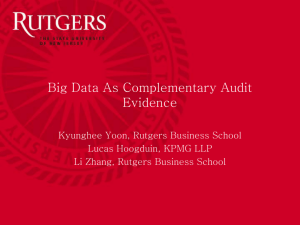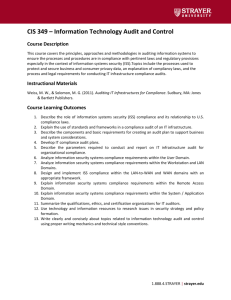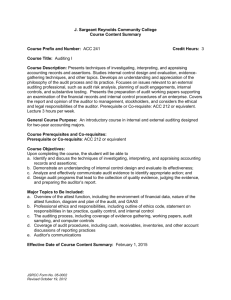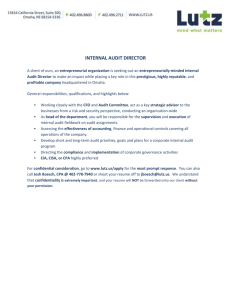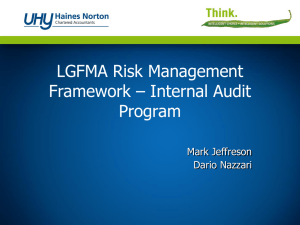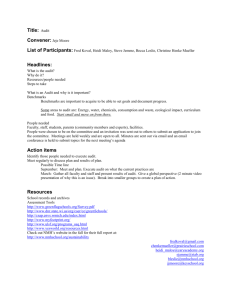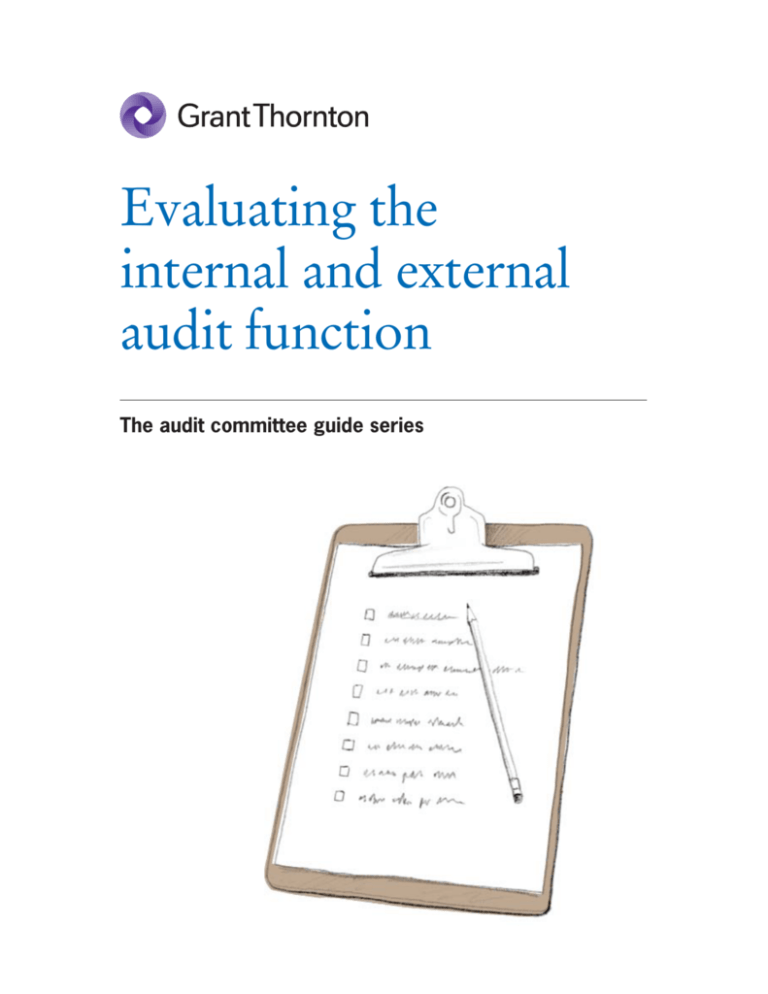
Evaluating the
internal and external
audit function
The audit committee guide series
“Effective audit
committees are critical
to the quality of financial
reporting and the proper
conduct of business. This
guide is one of a series
that is meant to help audit
committees meet their
oversight and fiduciary
responsibilities.”
– Trent Gazzaway, National Managing Partner
of Audit Services
Contents
2 Internal audit
2
Selection criteria
3
Audit committee considerations
5
Outsourcing considerations
6
Monitoring the internal
audit function
8 External audit
8
Selecting and evaluating
the external auditor
12 Non-audit services
13 External auditor reporting
14 Grant Thornton’s audit services
17 Suggested reading
18 Offices of Grant Thornton LLP
The audit committee guide series has been adapted from The Audit Committee
Handbook, Fifth Edition, published by John Wiley & Sons and available for
purchase at www.GrantThornton.com/ACHandbook and through major
online booksellers and bookstores nationwide.
There is some truth to the saying that being on an audit committee is a part-time
job with full-time responsibilities. Audit committees rely heavily on the hands-on
analysis provided by internal and external auditors, making it essential that the
audit work be evaluated for effectiveness and integrity.
How will financial reform impact your company?
The regulatory landscape is changing for companies and their audit committees. Go to
www.GrantThornton.com/FinancialReform to review Grant Thornton’s outline of key financial
reform issues and actions you can take to guide your company through them: “Financial reform:
What public companies and their audit committees need to know about the Dodd-Frank Act.”
Evaluating the internal and external audit function 1
Internal audit
Staffing internal audit is a joint exercise that includes input from the audit
committee and management. Several factors — such as an organization’s size,
complexity, level of risk and geographic diversity — can influence decisions
regarding the level of internal audit certification that may be desired.
Selection criteria
Audit committees and management might consider the following factors in staffing
an internal audit function:
• A strong leader — Internal audit leaders (often called chief audit executives
or directors of internal audit) must not be afraid to bring potential problems
to light.
• Reporting relationships — Regardless of its defined reporting relationship
to management and the board,1 internal audit should have frequent, open
and direct lines of communication with the audit committee, and the
freedom to address meaningful organizational risks.
• Need for specialists to deal with complex or difficult transactions.
• Geographic diversity — Organizations with wide geographic reach may
benefit from having internal audit personnel located near significant operations.
• Form of compensation fosters appropriate focus on audit quality.
• Objectivity or “independence” — Internal auditors should be familiar with
the subject matter, but should not be so closely tied to the area that their
neutrality is impaired.
1
Internal auditing standards recognize that a dual reporting relationship between management and the board can provide
the internal auditor with valuable access to both groups. See Braiotta, Louis Jr.; Gazzaway, R. Trent; Colson, Robert;
and Ramamoorti, Sridhar, The Audit Committee Handbook, Fifth Edition, John Wiley & Sons, Inc. (2010): 224, footnote 4.
2 Evaluating the internal and external audit function
Audit committee considerations
To ensure that the organizational framework for the internal auditing function is
comprehensive and balanced, the audit committee should consider the following
three areas.
Internal audit philosophy
Corporate accountability and governance necessitate an ongoing appraisal of the
entity’s auditing philosophy. Some internal audit functions focus exclusively or
primarily on operations, while others extend their focus to financial reporting.
The audit committee and management should:
• understand and agree with the operating philosophy, and
• be confident that internal audit has appropriately skilled resources
to execute on the chosen philosophy.
Internal audit independence
Appropriate levels of independence enable internal audit to design and
execute audit procedures in all necessary areas and fully support findings and
recommendations to management and the audit committee or the full board.
COSO’s Guidance on Monitoring Internal Control Systems contains some
helpful direction regarding the broad concept of objectivity.
Objectivity refers to the extent to which evaluators and information sources can
be expected to perform an evaluation or provide information with no concern about
possible personal consequences and no vested interest in manipulating the results for
personal benefit or self-preservation. Personal integrity is a primary consideration in
assessing objectivity, but other, more easily observed factors include compensation
incentives, reporting responsibilities, personal relationships and the degree to which
individuals might be otherwise affected by the results of monitoring.2
2
COSO, Guidance on Monitoring Internal Control Systems, vol. 2 (2009), par. 33.
Evaluating the internal and external audit function 3
Structure and logistics
Organizations, depending largely on their nature, size and complexity, have
different internal auditing needs. The audit committee should review the plans
and budgets of the internal auditors in relation to the entity’s auditing needs
and potential auditing benefits.
Equally important, the committee should review the organization chart of
the internal auditing function to determine that it is balanced in accordance with
the audit plan. An illustrative organization chart in Exhibit 1 shows how the
internal audit function of a multinational enterprise might be organized on a
centralized basis.
Exhibit 1: Sample internal audit organization chart
Audit Committee
Board of Directors
Chief Executive
Officer
Chief Financial
Officer
Chief Audit
Executive
Audit Director:
Corporate and
Domestic Ops
Audit Director:
International Ops
Manager:
Financial
and IT
Various Foreign
Subsidiary
Audit Managers
4 Evaluating the internal and external audit function
Manager:
Operational
and Special
Projects
Manager:
Compliance
Outsourcing considerations
Some organizations find it necessary to outsource some or all of their internal
audit function. Most public companies today are prohibited by statute or
regulation from outsourcing internal audit services to their external auditors.
The Institute of Internal Auditors (IIA) suggests that the following factors
be considered when evaluating possible outsourcing arrangements:3
• Independence of the external service provider
• Allegiance of in-house resources versus that of external service provider
• Professional standards followed by the external service provider
• Qualifications of the service provider
• Staffing — Training, turnover, rotation of staff, management
• Flexibility in staffing resources to meet engagement needs or special requests
• Availability of resources
• Retention of institutional knowledge for future assignments
• Access to best practice or insight to alternative approaches
• Culture of the organization — Receptiveness to external service providers
• Insight into the organization by the external service provider
• Coverage of remote locations
• Coordination with in-house internal auditing
• Coordination with external auditor
• Use of internal auditing as a training ground for internal promotions
• Retention, access to and ownership of work papers
• Acquisition and availability of specialty skills
• Cost considerations
• Good-standing membership in an appropriate professional organization
3
See IIA, Position Paper: “The Role of Internal Auditing in Resourcing the Internal Audit Activity,” 4.
Evaluating the internal and external audit function 5
Monitoring the internal audit function
The audit committee’s routine oversight of internal audit is beneficial for the
following reasons. First, it enhances the audit staff’s independence and strengthens
its image in the corporate structure. Second, the audit committee can help
coordinate internal and external audit activity, thus improving the efficiency of
both. Third, an effective internal audit function assists the audit committee in
discharging its responsibilities in light of its limited time and oversight capacity.
Appraising the quality of internal auditing staff
Chief audit executives (CAEs) should be able to articulate to the audit committee
how they meet the standards set forth by the IIA.4 Criteria for which the audit
committee should look include the following:
• Proficiency
• Due professional care
• Continuing professional development
• Internal and external quality assessments
• Reporting on the quality assurance and improvement program
The audit committee also should inquire of the independent auditor regarding
the quality of internal auditing personnel in relation to:
• the professional qualifications and educational backgrounds of the staff,
• the use of professional training and development programs for the corporate
audit staff, and
• the performance appraisal and evaluation system.
4
The IIA, International Professional Practices Framework (IPPF), Standards 1200 and 1300 (2009).
6 Evaluating the internal and external audit function
Finally, while each audit committee may develop its own approach to monitoring
the activities of the internal audit function, the following summary thoughts should
be helpful. In general audit committees should:
1. assist in the overall internal auditing policy determination and approve
such policies to ensure that the staff has authority commensurate with
its responsibilities;
2. review the scope of the internal and external auditing plans in order
to maximize the resources allocated to the audit function and minimize
the outside auditing fees;
3. review copies of the internal auditing reports and critically evaluate findings,
recommendations, management’s response and courses of action taken, and
review the disposition of the recommendations in the independent auditor’s
management letter;
4. review and appraise the staff’s organization regarding its auditing philosophy,
independence and logistical operations;
5. assess the quality of the auditing personnel and training to ensure that the
internal auditing function is adequately staffed;
6. assure the CAE that the audit committee supports his function in the corporate
structure and the director has access to the committee and the functional areas
within the entity, and obtain assurance that the staff is receiving the proper
cooperation from management; and
7. determine the need for specialists, such as in complex areas of accounting
or evaluation of computer security.
Evaluating the internal and external audit function 7
External audit
Selecting and evaluating the external auditor
Few decisions that audit committees make are more important than the
recommendation or selection of external auditors.5 Audit committee members
should, therefore, be diligent in selecting the right auditor and in evaluating the
auditor’s performance throughout the engagement. Exhibit 2 includes some
selection criteria for audit committee consideration. These same criteria also can
be used to evaluate the auditor’s performance during or at the end of an audit.
Exhibit 2: External auditor selection/evaluation criteria
Industry experience
Audit committees of large, complex organizations, and those that
venture into complicated industries like software or finance, need
to ensure the external auditors have an appropriate level of
industry experience.
5
Support network available
within the external auditing firm
Audit committees should be confident that the external auditor
has access to specialized technical resources — whether in a
national office or spread around its geographic footprint. Ask
the prospective auditor to describe the process for answering
a technical question that cannot be handled solely by the
engagement team.
Independence
Audit committees should be confident that the external auditor
has appropriately evaluated and reported the firm’s independence,
considering family relationships, investment holdings or other
business relationships. Independence requirements apply to the
engagement team, to the firm’s local office, and in most public
company situations, to the firm as a whole.
In some situations (such as the appointment of the external auditor for a company listed on a U.S. exchange), the audit
committee must select and engage the external auditor. In other countries, and with most private organizations, the
audit committee might merely recommend an audit firm to management, who then makes the decision regarding
engaging that firm.
8 Evaluating the internal and external audit function
Reasonableness of audit plan
The audit committee should be confident that the prospective
auditor’s audit scope is reasonable and adequate, and that it
includes locations that, on their own, are material to the financial
statements. Smaller locations may be included on a rotating or
limited-scope basis.
Audit committees should heed unusually low competitive bids,
which may signal that the auditor doesn’t understand the scope
required or that he plans to make up the difference through
special billing. Require proposing firms to quote both hours and
fees by major audit area to evaluate differences in hourly rates
(which may reflect the personnel level planned for the work)
and number of hours (which may reflect audit plan adequacy
or excessiveness).
Ability to toe the line
Audit committees should be confident that the audit partner
has the fortitude to deliver constructive criticism. Over time —
in executive session — ask open-ended questions about
management’s and/or internal audit’s performance, and
evaluate the partner’s demeanor and response.
To evaluate how well a prospective auditor communicates difficult
information, ask references or the audit partner for examples of
issues he has reported. Confidentiality may rightly prevent full
disclosure of such issues, but the audit committee should be
able to get a sense of the auditor’s candor.
Form and frequency
of communications
•
•
•
With management
With internal audit
With the audit committee
The audit committee should expect frequent, open auditor
communication with management and internal audit, and may
reasonably expect the auditor to spend time talking to managers
and employees outside of the executive suite.
Auditing standards require the auditor to have certain types
of communications with the audit committee (see External
auditor reporting on p. 13). At a high level the audit committee
should expect:
• An audit planning discussion early in the year describing
what the auditor plans to do, where he plans to do it and
how much effort he expects it to take
• Interim updates measuring progress against the plan
• Immediate communication of issues like suspected fraud,
major internal control problems or indication of a prior-period
material error
• A wrap-up presentation covering all required communications
set forth in Exhibit 3, updating the interim status and delivering
recommendations for improvement
Evaluating the internal and external audit function 9
Lack of surprises
Audit surprises, in this context, come in two forms:
• Those related to last-minute audit adjustments
• Those related to last-minute cost overruns
Both can be caused either by the company’s failure to provide
necessary information to the auditor by the agreed-upon date,
or by the auditor’s failure to perform necessary procedures
early enough to detect a particular problem. Proper interim
communication and routine audit committee/auditor exchanges
about the status of requested information usually prevent auditor
downtime, overruns and rushed audit procedures.
Partner and manager
involvement
A typical audit includes 20 to 30 percent partner/manager time,
but audit complexity can raise or lower those percentages. The
mix of partner and manager time also varies based on the number
of audit managers staffed and their level of experience.
The quality of the hours spent, especially by the partner, is more
important than the number of hours spent. The partner’s early
involvement in the planning process, frequent interim reviews
of the audit work, and adequate review time in the field translate
into an effective and efficient audit.
6
7
Quality control procedures
Auditors of public companies are required to have concurring
or second partner reviews,6 often called “engagement quality
reviews.” The audit committee should inquire about the skills
and involvement of the concurring partner, who should have
appropriate industry experience and be available to the
engagement team as needed.
Using the work of others
The audit committee should be confident that the external
auditor is making appropriate but not excessive use of the
internal control testing performed by others, including
internal audit.7
See Braiotta, Louis Jr.; Gazzaway, R. Trent; Colson, Robert; and Ramamoorti, Sridhar, The Audit Committee Handbook,
Fifth Edition, John Wiley & Sons, Inc. (2010): “The Engagement Team,” 211.
Ibid., “Using the Work of Others,” 214.
10 Evaluating the internal and external audit function
8
9
Usefulness of recommendations
External auditors are uniquely positioned to add value beyond
the assurance provided in the audit opinion, and audit committees
should be confident that the auditors they select have a continualimprovement mindset. With unprecedented access to business
operations and related books and records, and valuable knowledge
gained from other companies’ best practices, a good external
auditor should always look for ways to help organizations be
more effective and efficient, especially in their financial
reporting processes.
Team chemistry — Balancing
client relationships with duty
to financial statement users
Audit committees should expect the audit team to be courteous,
respectful and reliable, and at the same time, to maintain a
“healthy skepticism.”8 Committee members should ask
management periodically about the auditor relationship —
looking equally for signs of excessive tension and excessive
collegiality9 — and should ask the auditor about the nature
of management’s interactions.
The 2009 SEC Handbook, Section 603.07 states, “SEC registrants may, of course, change auditors at their discretion.
It is imperative, however, that when a new auditor is engaged that auditor possess the integrity, objectivity and
independence required by professional and Commission standards. The auditor must, at all times, maintain a
‘healthy skepticism’ to ensure that a review of a client’s accounting treatment is fair and impartial.”
The AICPA’s Audit Committee Toolkit (2004) states: “In considering information gathered through the process of
evaluating the independent auditor, it is important that the audit committee give consideration to the source of the
information. For example, if the CFO/controller comments that they believe the auditor went too far in certain areas,
that would probably carry less weight in your deliberations than if the CFO/controller comments that certain areas
were not tested adequately. As with all deliberative processes, the audit committee should consider the different
perspectives and motivations of those having input into the deliberations.”
Evaluating the internal and external audit function 11
Non-audit services
The Sarbanes-Oxley Act prohibits external auditors of U.S. public companies
from conducting certain non-audit services and has established a requirement for
boards (usually through their audit committees) to approve any other non-audit
services that are not specifically prohibited. The prohibited services are based on
three primary criteria: (1) an auditor cannot function in the role of management,
(2) an auditor cannot audit her own work, and (3) an auditor cannot serve in an
external advocacy role for her client.10 Prohibited services include:11
• Bookkeeping or other services related to the accounting records
or financial statements of the audit client
• Financial information systems design and implementation
• Appraisal or valuation services, fairness opinions, or
contribution-in-kind reports
• Actuarial services
• Internal audit outsourcing services
• Management functions or human resources
• Broker or dealer, investment adviser or investment banking services
• Legal services and expert services unrelated to the audit
• Any other service that the Public Company Accounting Oversight Board
determines, by regulation, is impermissible
Thousands of examples of good audit committee preapproval policies are available
on the Internet through the investor relations section of most public company
websites. Two such examples can be found at the links below.
• McDonalds Corporation: http://www.aboutmcdonalds.com/mcd/investors/
corporate_governance/audit_committee_policy.html
• PepsiCo Inc.: http://www.pepsico.com/Company/Corporate-Governance.html
10
11
See Preliminary note to Rule 2-01 of Regulation S-X, 17 CFR 210.2-01.
See the Sarbanes-Oxley Act of 2002, Section 201.
12 Evaluating the internal and external audit function
External auditor reporting
Auditing standards require the external auditor to communicate certain things
to “those charged with governance,” which usually includes management and
the board (through the audit committee).12 In general, the audit committee
should expect the auditor to communicate:
• the auditor’s responsibilities in relation to the financial statement audit,
• planned scope and timing of the audit,
• significant findings from the audit, and
• auditor independence.
Exhibit 3 lists the types of communications the audit committee should expect
from the auditor and a general time frame within which those communications
might be made.
Exhibit 3: Required external auditor communications to the audit committee
Communications
When delivered*
Independence and retention matters
Prior to acceptance and annually
Auditor’s responsibilities under the relevant auditing standards
Prior to commencing services
Audit committee preapproval of services
Prior to commencing services
Fraud and illegal acts
When event becomes known
Inquiries and investigations by authorities
When event becomes known
Significant accounting policies, judgments and estimates
End of audit
Auditor’s judgments about the quality of accounting principles
End of audit
Audit adjustments, including uncorrected misstatements
End of audit
Disagreements with management
End of audit
Difficulties encountered when performing the audit
End of audit
Management’s consultations with other accountants
End of audit
Material weaknesses and significant deficiencies in internal control
Prior to issuing report
Auditor’s internal quality control procedures
Prior to issuing report
Material issues raised during most recent quality control or peer review Prior to issuing report
Material written communications with management
Prior to filing
* If necessary, all of these matters should be discussed promptly on an interim basis with the audit committee.
12
See ISA 260 and SAS No. 114.
Evaluating the internal and external audit function 13
Grant Thornton’s audit services
Credible, timely and relevant financial information is fundamental to promoting
confidence in a company. Audit committees, as well as management, play a
unique role in establishing and maintaining that confidence. Because audit
committee members must rely heavily on both internal and external auditors
being independent and candid, finding the right auditors is paramount to the
audit committee’s oversight role.
Grant Thornton provides audit solutions that offer real value to today’s
dynamic global organizations. For over 80 years, we have served a wide range
of private and public clients across America’s heartland. With Grant Thornton,
you get:
• access to industry specialists and technical resources;
• local support from our 48 U.S. offices and access to the global resources
of Grant Thornton International Ltd member and correspondent firms
in more than 100 countries;
• a high level of partner involvement and personalized service;
• experienced professionals who have the leadership and communications
skills to deliver constructive feedback on complex issues; and
• quality services delivered consistently with state-of-the art tools.
14 Evaluating the internal and external audit function
Contact us for help with either your internal or external audit needs
Warren Stippich
Trent Gazzaway
Partner and National Governance,
Risk and Compliance Solution Leader
T 312.602.8499
E Warren.Stippich@us.gt.com
National Managing Partner
of Audit Services
T 312.602.8034
E Trent.Gazzaway@us.gt.com
Evaluating the internal and external audit function 15
Subscribe to Grant Thornton publications at www.GrantThornton.com/Subscribe
Receive relevant white papers and timely updates on industry issues and the regulatory environment.
CorporateGovernor white paper series
Ensure your public company is run well and in accordance with applicable laws and regulations. Explore
a range of topics from fraud prevention and detection to financial reporting control and SOX compliance:
Enterprise risk management: Creating value in a volatile economy
discusses why implementing an enterprise risk management (ERM) program
can benefit companies in a down economy and how ERM can help enhance
business strategy.
Hear that whistle blowing! Establishing an effective complaint-handling
process addresses an important mandate of the Sarbanes-Oxley Act: the
requirement that audit committees establish procedures for receiving,
documenting and handling complaints related to accounting and auditing matters.
Fraud in the economic recovery
As companies pick up the pieces following a bruising bout of the economic
blues, they need to be on the lookout for fraud. From heightened fraud risk to
due diligence strategies for companies purchasing distressed assets, this
CorporateGovernor white paper provides a sound overview of fraud prevention
in today’s economic environment.
Timely updates
Tailored to management, boards and audit committees of mid-cap public companies, these updates
help you stay abreast of issues that affect the marketplace and your business.
Boardroom awareness: Service organization reports in transition
to new U.S. and international standards
In this issue of CorporateGovernor newsletter, Grant Thornton advisory
professionals discuss the new service organization reporting standards that are
set to replace Statement on Auditing Standards No. 70 (SAS 70) by mid-2011.
Information overload: How to make data analytics work for the internal
audit function
Learn how your internal audit department can effectively use data analytics to
add value to your organization.
16 Evaluating the internal and external audit function
Suggested reading
The Audit Committee Handbook, Fifth Edition (Wiley, 2010,
ISBN: 978-0-470-56048-8, U.S. $95.00).
The Audit Committee Handbook is co-authored by Grant Thornton LLP
audit committee experts R. Trent Gazzaway, national managing partner of Audit
Services, and Robert H. Colson, retired partner in Public Policy and External
Affairs, along with Louis Braiotta Jr., professor of accounting at SUNY —
Binghamton’s School of Management, and Sridhar Ramamoorti, principal at
Infogix Advisory Services. The Audit Committee Handbook provides practical,
in-depth guidance on all audit committee functions, duties and responsibilities.
This latest edition features regulatory updates, new chapters on audit planning
and oversight, heightened focus on fraud risk, and broad international coverage.
The Audit Committee Handbook is available at www.GrantThornton.com/
ACHandbook and through major online booksellers and bookstores nationwide.
The Anti-Corruption Handbook: How to Protect Your Business in the Global
Marketplace (Wiley, 2010, ISBN: 978-0-470-61309-2, U.S. $75.00)
Today’s demanding marketplace expects CFOs, auditors, compliance officers
and forensic accountants to take responsibility for fraud detection. These
expectations are buoyed by such legislation as the Foreign Corrupt Practices
Act, which makes it a crime for any U.S. entity or individual to obtain or retain
business by paying bribes to foreign government officials. Written by William
P. Olsen, the national practice leader of Forensics, Litigation and Investigation
Services at Grant Thornton LLP, The Anti-Corruption Handbook provides
guidelines addressing the challenges of maintaining business integrity in the
global marketplace.
Evaluating the internal and external audit function 17
Grant Thornton LLP offices
National Office
175 West Jackson Boulevard
Chicago, IL 60604
312.856.0200
National Tax Office
1250 Connecticut Ave. NW,
Suite 400
Washington, DC 20036-3531
202.296.7800
Arizona
Phoenix
California
Irvine
Los Angeles
Sacramento
San Diego
San Francisco
San Jose
Woodland Hills
Colorado
Denver
Florida
Fort Lauderdale
Miami
Orlando
Tampa
Georgia
Atlanta
602.474.3400
949.553.1600
213.627.1717
916.449.3991
858.704.8000
415.986.3900
408.275.9000
818.936.5100
303.813.4000
954.768.9900
305.341.8040
407.481.5100
813.229.7201
404.330.2000
Illinois
Chicago
312.856.0200
Oakbrook Terrace 630.873.2500
Kansas
Wichita
316.265.3231
Maryland
Baltimore
410.685.4000
Massachusetts
Boston
617.723.7900
Oklahoma
Oklahoma City
Tulsa
405.218.2800
918.877.0800
Oregon
Portland
503.222.3562
Pennsylvania
Philadelphia
215.561.4200
Michigan
Detroit
248.262.1950
Minnesota
Minneapolis
South Carolina
Columbia
803.231.3100
612.332.0001
Texas
Austin
Dallas
Houston
San Antonio
512.391.6821
214.561.2300
832.476.3600
210.881.1800
Utah
Salt Lake City
801.415.1000
Virginia
Alexandria
McLean
703.837.4400
703.847.7500
Washington
Seattle
206.623.1121
Missouri
Kansas City
St. Louis
816.412.2400
314.735.2200
Nevada
Reno
775.786.1520
New Jersey
Edison
732.516.5500
New York
Long Island
Downtown
Midtown
631.249.6001
212.422.1000
212.599.0100
North Carolina
Charlotte
704.632.3500
Raleigh
919.881.2700
Ohio
Cincinnati
Cleveland
18 Evaluating the internal and external audit function
513.762.5000
216.771.1400
Washington, D.C.
Washington, D.C. 202.296.7800
Wisconsin
Appleton
Milwaukee
920.968.6700
414.289.8200
© Grant Thornton LLP
All rights reserved
U.S. member firm of Grant Thornton International Ltd
The people in the independent firms of Grant Thornton International Ltd provide personalized attention and the highest
quality service to public and private clients in more than 100 countries. Grant Thornton LLP is the U.S. member firm of
Grant Thornton International Ltd, one of the six global audit, tax and advisory organizations. Grant Thornton International Ltd
and its member firms are not a worldwide partnership, as each member firm is a separate and distinct legal entity.
In the U.S., visit Grant Thornton LLP at www.GrantThornton.com.


